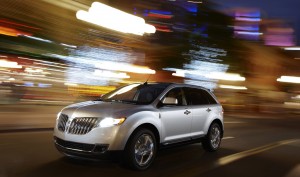
Lincoln topped the American Consumer Satisfaction Index for the second quarter of 2012, reflecting a loyal, although dwindling, core group of buyers.
Lincoln took the lead in a key customer satisfaction survey in the second quarter of 2012, reflecting a loyal, though dwindling core group of buyers, while at the other end of the spectrum, Chrysler continued to bring up the rear although it is showing improvement.
Ann Arbor, Mich.-based American Customer Satisfaction Index said that overall, aggregate customer satisfaction stayed flat at 75.9 on a 100-point scale.
Domestic nameplates showed the greatest improvement overall, but they continue to trail both European and Asian cars. Among the U.S. automakers, Ford continues to hold the lead at 86 (+1%), followed by an unchanged General Motors at 84. Chrysler stayed in last place overall, but made the most progress in customer satisfaction with a 4% surge to 81.
As in most years, luxury brands set the pace in customer satisfaction, ACSI said. Lincoln led the survey with a score of 90 (+5), followed closely by Toyota’s Lexus brand at 89, up 2% from its industry-leading score last year. Likewise, GM’s Buick nameplate gained 2% to 87, while Cadillac dipped 1% to 86. Germany’s BMW rebounded from a sharp decline a year ago by jumping 4% to tie Cadillac at 86. BMW regained its customer satisfaction prowess at the same time as the company achieves its second-best-ever operating profit.
Subaru’s score of 87 was the lone exception to luxury-plate dominance this year. The Japanese automaker rode a wave of increasing market share at a time when most automakers’ sales were declining.
Several automakers clustered at—or within 1 point of—the industry average of 84. The above-average group at 85 includes Hyundai (+2), Mercedes-Benz (-1%), Toyota (-2%), and Volkswagen (+1%). Those just below average at 83 are Ford (-1%), Honda (-2%), Jeep (+5%), and Nissan (-1%). GM’s Chevrolet rises 2% to match the average at 84. The ACSI loss for Toyota’s namesake brand is enough to strip away its number-one title from 2011, while Honda’s downturn places it below average for the first time in ACSI history.
“While Japan’s production is back on track after last year’s earthquake and tsunami, both Toyota and Honda have had quality issues as they race to recapture market share,” said Claes Fornell, ACSI founder. “These two automakers, once known for setting the bar for quality, have issued a large number of recalls over the past year. ACSI data show that recalls for quality defects have a negative impact on customer satisfaction for automobile manufacturers.”
Customer satisfaction with the automobile and light vehicle industry improves for a second straight year, up 1.2% over last year to reach 84.
While domestic nameplates showed the greatest improvement overall, they continue to trail both European and Asian cars. Among the U.S. automakers, Ford continued to hold the lead at 86 (+1%), followed by an unchanged General Motors at 84. Chrysler stayed in last place overall, but makes the most progress in customer satisfaction with a 4% surge to 81.
As in previous years, luxury brands have the upper hand when it comes to pleasing customers. Lincoln recaptured the industry lead with a 5% gain to 90. The downside for Lincoln is that high satisfaction may reflect a loyal, but dwindling, customer base.
Toyota’s Lexus follows closely in second place at 89, up 2% from its industry-leading score last year. Likewise, GM’s Buick nameplate gains 2% to 87, while Cadillac dips 1% to 86. Germany’s BMW rebounds from a sharp decline a year ago by jumping 4% to tie Cadillac at 86. BMW regains its customer satisfaction prowess at the same time as the company achieves its second-best-ever operating profit.
Subaru’s score of 87 is the lone exception to luxury-plate dominance this year.
Several automakers clustered at—or within 1 point of—the industry average of 84. The above-average group at 85 includes Hyundai (+2), Mercedes-Benz (-1%), Toyota (-2%), and Volkswagen (+1%). Those just below average at 83 are Ford (-1%), Honda (-2%), Jeep (+5%), and Nissan (-1%). GM’s Chevrolet rose 2% to match the average at 84. The ACSI loss for Toyota’s namesake brand is enough to strip away its number-one title from 2011, while Honda’s downturn places it below average for the first time in ACSI history.
“While Japan’s production is back on track after last year’s earthquake and tsunami, both Toyota and Honda have had quality issues as they race to recapture market share,” Fornell said. “These two automakers, once known for setting the bar for quality, have issued a large number of recalls over the past year. ACSI data show that recalls for quality defects have a negative impact on customer satisfaction for automobile manufacturers.”
While Ford and GM show a mixture of gains and declines across their nameplates, all three Chrysler brands move forward in 2012. The company’s Dodge and Chrysler nameplates improve 3% to 81 and 78, respectively, while Jeep accelerates 5% to 83—an all-time high. This rise in customer satisfaction marks a strong resurgence for Chrysler, which also is reflected in consumer demand. Chrysler’s year-to-date sales are up 28%, outpacing Ford and GM’s growth of 5% and 3%, respectively.
Nevertheless, Chrysler continues to play catch up in the overall ACSI rankings for the industry. Among its three brands, all are below the industry average for customer satisfaction. Additionally, both Dodge and Chrysler continue to hug the bottom of the industry, posting the third-worst and worst scores this year. Sandwiched between the two, GM’s GMC product line tumbles 4% to 80.
Two Asian carmakers are nestled among the Chrysler brands at the low end of the industry list: Mazda and Kia at 82. While Mazda zooms up 4% this year to match its all-time ACSI high, the company continues to be a below-average performer compared with other brands.
